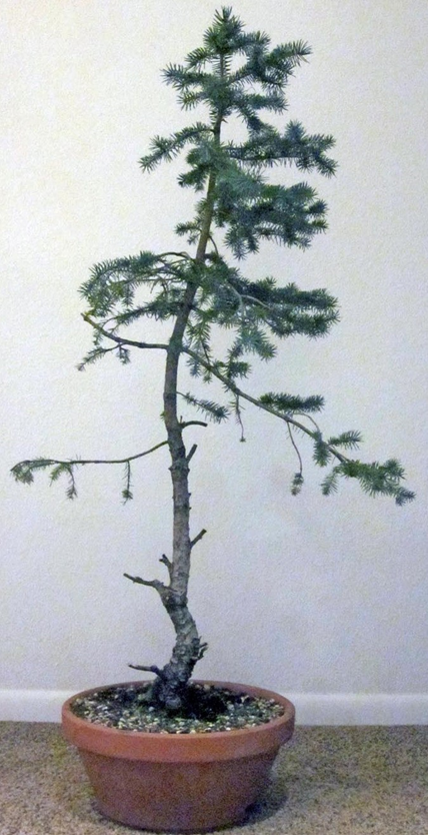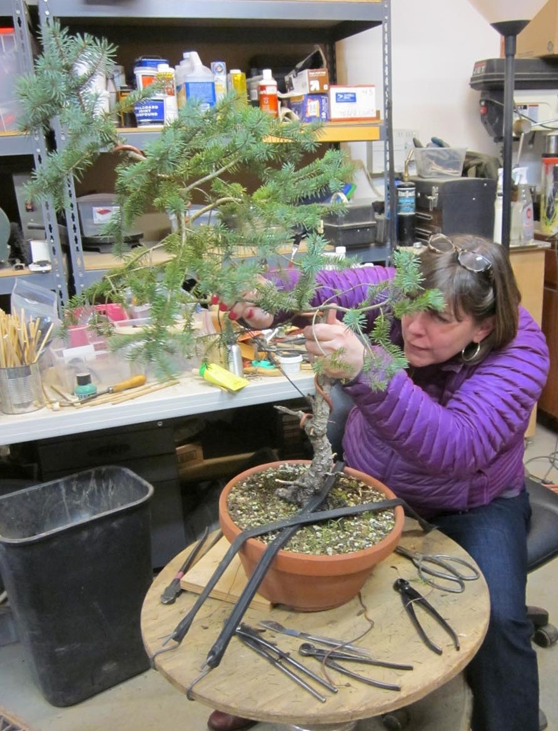I have two wisteria that I have been growing for several years. Their varieties are different but they are usually tracking on the same schedule and routine throughout the year. I was a bit alarmed this spring when one blossomed and leafed out as usual, but the other one did nothing. I did see a few balls of green, where a few wimpy flower buds were slowly surfacing – that’s the first thing that you see in spring on a wisteria. The flower buds usually swell to almost golf ball size before elongating. But these were more like a pencil eraser.
I told my wife that the tree was probably toast, and I was a bit sad as it came from my long time bonsai buddy, Alan Taft. But I left it on the bench and kept watering it, though cautiously. The branches were very dry looking, very dead. I had been having trouble with both wisteria the last two years, as with some other deciduous trees, not being as vigorous as I had hoped, so this was not a complete surprise. But later in the spring, I started to see more little green dots appear on the wood, which was quite unexpected. Then I started seeing more specks and they began elongating. You see them in the first photo.
Notice the dead buds at the tip of the branch. Those were flower buds last fall. This is happening all over the tree, and once it began, the trees eschewed the few flower buds for foliar growth. It’s growing gangbusters now, maybe growing twice as fast and more vigorously than it ever has. If you look at the second photo, you will see it is crowding everything out on the bench. The other wisteria is to the left, with simple, restrained growth (low fertilizer). The tree in question though, is busting out all over. It usually puts out but a few tendrils a year, but you can clearly see them crawling all over everything at the moment, reaching over to other trees on adjacent benches. You can kind of tell that it’s a semi-cascade by looking where the end of the bench stops, and the tree just keeps on going.
Now, I have no real explanation for what has happened with this tree, but similar things happen once in a while. Something known or unknown impacts the tree to where it is near death or appears to be. Then it summons all of its power from within and bursts forth with new growth. We have to be careful, as it is expending all its reserves to survive. When it happens, the tree is usually budding back on older wood, many times in a place where we were unable to make it bud previously. It can be fortuitous. We sort of do this in a controlled, predictable fashion when we decandle a black pine, or defoliate a maple tree, and to lesser degree with regular pruning. Rarely though, do we impact a tree beyond where we have total confidence of recovery. I would not induce this on purpose, but it can actually turn out making the tree better in the long run – if it doesn’t die in the process.
All of this is a long introduction into summer care. What could I possibly be talking about? If you have grown bonsai for even one season, you have probably had the experience of a tree beginning to wilt, and then watering it and watching it perk back up. That’s usually in the spring as a tree is elongating and hasn’t hardened off yet – that is, built the outer protective
layer called a cuticle. But then there is that instance during the summer where inevitably there is going to be a tree that gets scorched in the hot sun and acquires a bit of color, like when we get some sunburn ourselves. We just deal with it but it’s not life threatening. Then there is that time when things start to get crispy. That’s bad news. Sometimes it’s just a portion of the tree, or in other cases, the whole shebang. So my admonition is to be patient. If you see the sudden collapse of a tree, don’t panic. Soak it in a tub to quickly get it hydrated. Then stop watering until it starts to get dry. A tree that was healthy before the incident has plenty of reserves to rebuild with. You will likely see some new growth peeking out in a few weeks.
However, if the tree is slowly going downhill over several weeks and is starting to dry up, the cause is something other than a single let down in watering or over exposure. You will have to discover it quickly and the tree may even be gone at that point. If the branches are starting to desiccate, that’s not a good sign. Moisture is withdrawing and slowly dying back. It is very likely a root issue. It could be a systemic fungus like Phytophthora, which can be hard to deal with. Specific chemicals like Allude, Aliette, and Subdue Maxx, Agri-Fos can help.
But that is a last resort. Healthy trees and good watering practices are the key here. If it is just looking scorched and yellow/rust colored mottling on the outer portions, it may a fungus like pythium, anthracnose and others. I have long desired to work on a more comprehensive guide, but alas, the time. Check back in the archives of this column for additional info. Just don’t give up hope too quickly.
Other issues can be self-induced. This is the time of year to evaluate the spring growth and prune where necessary. Saving length where you need it, cutting back where you don’t and slowing the tree down. Your trees may be in different stages of development, so the pruning will change accordingly.
The thing to remember here is that if you open up the canopy to the interior, those leaves don’t have the same cuticle and solar protection that the outer leaves had. It also opens up the trunk to sun scald, a problem I have encountered myself. So if you thin the tree extensively, think about protecting it in light shade until new leaves grow or existing leaves become acclimated to the new found sunlight. While you are doing the pruning, it’s also a great time to wire your deciduous trees. Just be sure to watch them for cutting in. Enjoy the summer of bonsai.
Scott Elser















































































